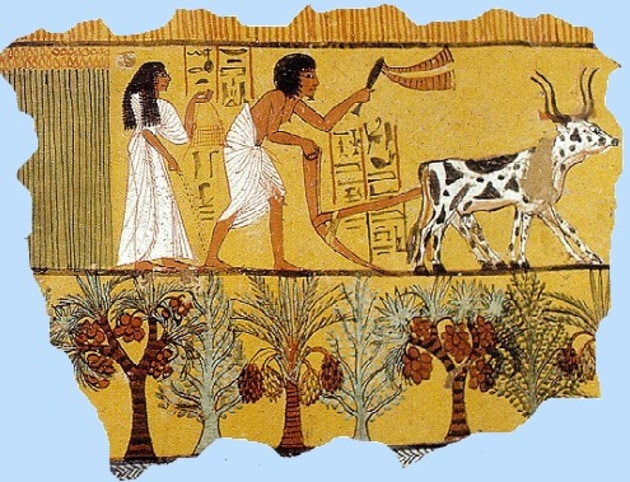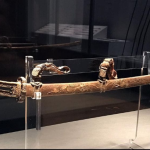Fields being plowed, crops being harvested, and grain being threshed by ancient Egyptian laborers

The ancient Egyptians enjoyed a variety of foods, not unlike what we enjoy today. Nevertheless, compared to many other ancient civilizations, the ancient Egyptians had access to better foods. The Nile River provided irrigation for crops and water for livestock. Generally speaking, bread and beer were the staples of ancient Egyptian cuisine. Fruits, vegetables, and fish were commonly eaten by the poor, while meat and poultry were more often eaten by the rich.
Bread and beer were the two staple products of ancient Egyptian cuisine. Bread was eaten by both the rich and the poor and was made using wheat or barley. Bread was made on a daily basis and was an arduous task. The grains were first grounded into flour, a job usually carried out by women. In order to speed up the grinding process, sand would be added into the grinding mill along with the grains. Although this allowed the flour to be produced faster, it also meant that the bread would have sand in it. This is evident in the teeth of mummies, which have been found to be worn down to the pulp as a result of biting on the sand in their food throughout their lifetime. By mixing the flour with water and yeast, dough would be formed, which would then be placed in a clay mold before being cooked in a stone oven.
To make beer, a special type of bread, referred to as ‘beer bread’ by archaeologists, was used. This bread contained a higher amount of yeast than other breads and was baked at a temperature that did not kill the yeast culture. The ‘beer bread’ would be crumbled into vats, and left to ferment naturally in water, thus producing beer. The beer of the ancient Egyptians was a thick and frothy drink that was highly nutritious. This drink was consumed not so much for pleasure, but rather out of necessity, as water from the Nile was not already clean and safe enough for people to drink.

The agricultural practices of ancient Egypt were a cornerstone of the civilization’s prosperity and longevity. At the heart of these practices were the laborers who toiled day in and day out, ensuring that the land yielded enough produce to support the population. These workers were involved in various essential activities, including plowing fields, harvesting crops, and threshing grain. Their efforts not only sustained daily life but also played a crucial role in the economic and social structure of ancient Egypt.
Plowing the fields was the first step in the agricultural process. Ancient Egyptian laborers used simple yet effective tools such as wooden plows, often pulled by oxen, to break up the fertile soil of the Nile Delta. This region, enriched by annual floods, provided the perfect environment for farming. The plowing process aerated the soil, making it easier to plant seeds and ensuring better water absorption. This crucial activity marked the beginning of the planting season and set the stage for a successful harvest.

Once the fields were plowed and seeds sown, the crops were left to grow under the watchful eye of the laborers. When the time came to harvest, it was a communal effort involving men, women, and children. The primary crops grown in ancient Egypt included wheat, barley, flax, and various fruits and vegetables. Harvesting was a labor-intensive process that required precision and teamwork. Workers used sickles, often made from flint or bronze, to cut the ripe crops. The harvested produce was then gathered and transported to storage facilities or threshing floors.
Threshing the grain was the next critical step in the agricultural cycle. This process involved separating the edible part of the grain from the chaff, which was an essential step in preparing the crop for consumption and storage. Ancient Egyptian laborers used a variety of methods for threshing, including beating the grain with flails or allowing animals to trample it. The grain was then winnowed, usually by tossing it into the air so that the wind could blow away the lighter chaff, leaving the heavier, edible grains behind. This labor-intensive process ensured that the population had a steady supply of food throughout the year.

The work of ancient Egyptian laborers extended beyond just these activities. They were also involved in maintaining irrigation systems, constructing storage granaries, and managing livestock. The irrigation systems were particularly vital, as they controlled the distribution of water from the Nile to the fields, ensuring that crops received adequate moisture even during dry periods. This elaborate network of canals and dikes required constant maintenance and supervision, underscoring the laborers’ critical role in sustaining agricultural productivity.
The contributions of these laborers were recognized and respected within ancient Egyptian society. Agricultural workers were often depicted in tomb paintings and other artworks, highlighting their importance in daily life and the economy. These depictions show scenes of plowing, sowing, reaping, and threshing, offering a glimpse into the laborious yet essential tasks that sustained the civilization.
In conclusion, the laborers of ancient Egypt played an indispensable role in the agricultural processes that underpinned their society. Through their diligent efforts in plowing fields, harvesting crops, and threshing grain, they ensured the sustenance and prosperity of their civilization. Their work not only provided food but also contributed to the economic and social stability of ancient Egypt, allowing it to flourish for millennia. The legacy of these laborers is a testament to the vital importance of agriculture in human history.











